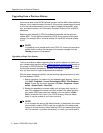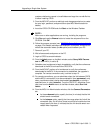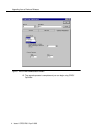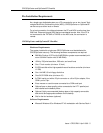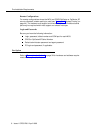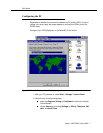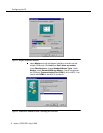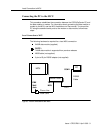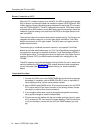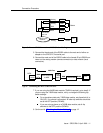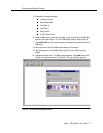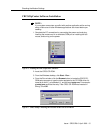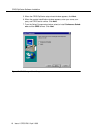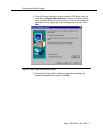
10 Issue 1 CRCS R6.0 April 1999
Connecting the PC to the MCU
Remote Connection to MCU
When the PC is located remotely from the MCU, the MCU’s modem pooling capa-
bility is ideal for connecting the data link needed to support CRCS/OpCenter. With
modem pooling, Hayes-compatible analog modems are used at the PC to connect
over the PTSN to the MCU. The MCU implements an external 7400A data module
combined with a 3800 modem running 9600 bps to provide conversion resources
needed to route the analog voice calls from the CRCS to the digital Netcon chan-
nels in the MCU.
There are two types of conversion resources for modem pooling. The first type, an
integrated conversion resource, is a circuit pack which emulates a Trunk Data
Module connected to a 212A-type modem. The MCU does not support the inte-
grated modem solution.
The second type, a combined conversion resource, is a separate Trunk Data
Module and modem administered as a unit. The Trunk Data Module component of
the conversion resource may be either a Modular Trunk Data Module (MTDM) or
a 7400A data module. The module connects to a digital port using Digital Commu-
nications Protocol (DCP); the 3800 modem connects to an analog port on the
TN746B.
The MCU supports the Combined Modem Pooling Solution for use in remote con-
nectivity between the MCU and the CRCS module whenever these components
are not collocated. See "Appendix A: Modem Pooling" for further installation
details.
Connection Procedure
1. Connect the COM1 port to the 8400B/7400B data module with an appropri-
ate adapter, if necessary, and an M25B (EIA-232-D) cord or equivalent. If
using modem pooling, use an analog modem instead.
2. Use an RS232 cable (M25B) with a 25-pin female connector for the CRCS
PC or server and a 25-pin male connector for the analog modem (remote
connection) or data module (local connection).
3. If your supplied cable does not have the appropriate gender connectors,
use a gender changer to make the adjustments.
4. PC ports are usually labeled with the port number and type (serial or paral-
lel), if not see your PC user manual for proper labeling. If the first serial port
is a 9-pin connector, connect a 9-pin-to-25-pin RS232 adapter (you sup-
ply).



